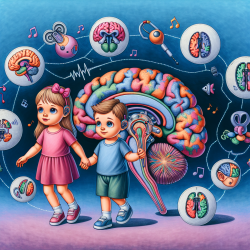Introduction
Congenital sensorineural hearing loss (CSNHL) in preschool children presents a significant challenge to auditory and language development. Recent research using resting-state functional MRI (rs-fMRI) has provided insights into how the cerebral cortex reorganizes in response to auditory deprivation. This blog explores the findings of a study titled "Cerebral cortex functional reorganization in preschool children with congenital sensorineural hearing loss: a resting-state fMRI study," highlighting the implications for practitioners working with children who have undergone cochlear implantation (CI).
Key Findings from the Study
The study analyzed 63 preschool children with CSNHL and 32 healthy controls, focusing on the amplitude of low-frequency fluctuation (ALFF) and regional homogeneity (ReHo) in the brain. Key findings include:
- Reduced ALFF and ReHo in Auditory Regions: Children with CSNHL exhibited lower ALFF values in the bilateral prefrontal cortex and superior temporal gyrus, indicating reduced spontaneous neural activity in these auditory regions.
- Increased ALFF in Visual and Somatosensory Regions: Higher ALFF values were observed in the bilateral thalamus and calcarine gyrus, suggesting compensatory activity in visual processing areas.
- Enhanced Functional Connectivity (FC): The study found increased FC in the visual cortex, proprioceptive cortex, and motor cortex, indicating cross-modal reorganization.
Implications for Practitioners
Understanding these neural changes is crucial for practitioners involved in the care and rehabilitation of children with CSNHL. Here are some key takeaways:
- Early Intervention is Critical: The findings underscore the importance of early diagnosis and intervention, ideally before the age of 3.5 years, to capitalize on the brain's plasticity.
- Multisensory Approach: Given the cross-modal reorganization observed, incorporating multisensory approaches in therapy may enhance outcomes.
- Continuous Monitoring: Regular follow-ups using neuroimaging can help assess the effectiveness of interventions and adjust strategies accordingly.
Encouraging Further Research
While this study provides valuable insights, it also opens avenues for further research. Future studies could explore the long-term effects of CI on cortical reorganization and the potential for reversing or mitigating these changes through targeted therapies.
Conclusion
The study highlights significant cortical reorganization in preschool children with CSNHL, emphasizing the need for early and comprehensive intervention strategies. Practitioners are encouraged to integrate these findings into their practice to improve auditory and language outcomes for children with hearing loss.
To read the original research paper, please follow this link: Cerebral cortex functional reorganization in preschool children with congenital sensorineural hearing loss: a resting-state fMRI study.










